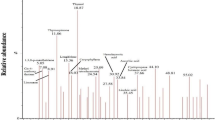Abstract
The efficacy of diallyl trisulfide (DATS) against arsenic (As) induced dyslipidemia in the plasma and livers of rats was studied. Oral administration of As [5 mg/kg of body weight (BW)/day] for 4 weeks showed significant (p<0.05) increases in TC, LDL-C, VLDL-C, FFA, PL, and TG levels and the activity of HMG-CoA reductase in the plasma and liver, with significant (p<0.05) reductions in levels of HDL-C hepatic ubiquinones and activities of LCAT and LPL in the plasma and liver. Oral administration of DATS (80 mg/kg of BW) for 4 weeks in As intoxicated rats significantly (p<0.05) reduced plasma and liver TC, FFA, TGs, VLDL-C, and LDL-C levels, and the activity of HMG-CoA reductase, and significantly (p<0.05) increased the activities of LCAT and LPL and the levels of HDL-C and ubiquinone in the livers of rats. DATS protects against As-induced dyslipidemia in rats.
Similar content being viewed by others
References
Shi HL, Shi XL, Liu KJ. Oxidative mechanism of arsenic toxicity and carcinogenesis. Mol. Cell. Biochem. 255: 67–78 (2004)
Wu MM, Chiou HY, Hsueh YM, Hong CT, Su CL, Chang SF, Huang WL, Wang HT, Wang YH, Hsieh YC, Chen CJ. Effect of plasma homocysteine level and urinary monomethylarsonic acidon the risk of arsenic-associated carotid atherosclerosis. Toxicol. Appl. Pharm. 216: 168–175 (2006)
Hayashi K, Mani V, Aguiar S, Fuster V, Fayad ZA. Variations in atherosclerosis and remodeling patterns in aorta and carotids. J. Cardiovasc. Magn. R. 12: 10–12 (2010)
Hsieh YC, Hsieh FI, Lien LM, Chou YL, Chiou HY, Chen CJ. Risk of carotid atherosclerosis associated with genetic polymorphisms of apolipoprotein E and inflammatory genes among arsenic exposed residents in Taiwan. Toxicol. Appl. Pharm. 227: 1–7 (2008)
Chattopadhyay S, Smarajit M, Gurupada M, Bimal D, Bappaditya P, Debidas G. Protective role of Moringa oleifera (Sajina) seed on arsenic-induced hepatocellular degeneration in female albino rats. Biol. Trace Elem. Res. 142: 200–212 (2011)
Yousef IM, El-Demerdash MM, Radwan FME. Sodium arsenite induced biochemical perturbations in rats: Ameliorating effect of curcumin. Food Chem. Toxicol. 48: 3506–3511 (2008)
Joshia SC, Bairwaa GL, Nidhi S. Effect of Amomum subulatum on oxidative stress and serum lipids in cholesterol fed rabbits. Int. J. Nat. Pro. Res. 1: 1–6 (2012)
Sumedha NC, Miltonprabu S. Antioxidant efficacy of diallyl trisulfide on arsenic-induced toxicity in rats: An in vivo and in vitro study. Int. J. Toxicol. Appl. Pharm. 3: 33–38 (2013)
Lii CK, Huang CY, Chen HW, Chow MY, Lin YR, Huang CH, Tsai CW. Diallyl trisulfide suppresses the adipogenesis of 3T3-L1 preadipocytes through ERK activation. Food Chem. Toxicol. 50: 478–484 (2012)
Folch J, Lees M, Solane SGH. A simple method for isolation and purification of total lipids from animal tissues. J. Biol. Chem. 26: 497–509 (1957)
Zlatkis A, Zak B, Boyle GJ. A simple method for determination of serum cholesterol. J. Clin. Med. 41: 486–492 (1953)
Fossati P, Lorenzo P. Serum triglycerides determined colorimetrically with an enzyme that produces hydrogen peroxide. Clin. Chem. 28: 2077–2080 (1982)
Zilversmit BB, Davis AK. Micro determination of plasma phospholipids by trichloroacetic acid precipitation. J. Lab. Clin. Med. 35: 155–160 (1950)
Fiske CH, Subbarow Y. The colorimetric determination of phosphorus. J. Biol. Chem. 66: 375–400 (1925)
Falholt K, Falholt W, Lund B. An easy colorimetric method for routine determination of free fatty acids in plasma. Clin. Chim. Acta 46: 105–111 (1973)
Burnstein M, Scholnic MR, Mortin R. Rapid method of isolation of lipoprotein from human serum by precipitation of poly anion. J. Lipid Res. 11: 583–587 (1970)
Wilson P, Abbott R, Castelli W. High density lipoprotein cholesterol and mortality. The Framingham heart study. Arteriosclerosis 8: 737–741 (1988)
Philipp B, Shapiro DJ. Improved methods for the assay and activation of 3-hydroxy-3-methyl glutaryl coenzyme A reductase. J. Lipid Res. 20: 588–593 (1970)
Hitz J, Steinmetz J, Siest G. Plasma lecithin: Cholesterol acyltransferasereference values and effects of xenobiotics. Clin. Chim. Acta 133: 85–96 (1983)
Korn ED. Clearing factor: A heparin activated lipoprotein lipase: Isolation and characterization of enzyme from normal rats. J. Biol. Chem. 215: 1–26 (1955)
Elmberger PG, Eggens I, Dallner G. Conditions for quantitation of dolichyl phosphate, dolichol, ubiquinone, and cholesterol by HPLC. Biomed. Chromatogr. 3: 20–28 (1989)
Muthumani M, Milton Prabu S. Silibinin attenuates arsenic induced alterations in serum and hepatic lipid profiles in rats. J. Appl. Pharm. Sci. 3: 132–138 (2013)
Pari L, Ramakrishnan R. Protective effect of tetrahydrocurcumin on plasma lipids and lipoproteins in cadmium intoxicated rats. Int. J. Toxicol. Appl. Pharm. 3: 26–32 (2013)
Jomova K, Jenisova Z, Feszterova M, Baros S, Liska J, Hudecova D, Rhodesd CJ, Valkoc M. Arsenic: Toxicity, oxidative stress, and human disease. J. Appl. Toxicol. 31: 95–107 (2011)
Ratnaike RN. Acute and chronic arsenic toxicity. Postgrad. Med J. 79: 391–396 (2003)
Horie T, Awazu S, Itakura Y, Fuwa T. Identified diallyl polysulfides from an aged garlic extract, which protects the membranes from lipid peroxidation. Planta Med. 58: 468–469 (1992)
Harenberg J, Geese C, Zimmermann R. Effect of dried garlic on blood coagulation, fibrinolysis, platelet aggregation, and serum cholesterol levels in patients with hyperlipoproteinemia. Atherosclerosis 74: 247–249 (1988)
Wang YN, Xiao KQ, Liu JL, Dallner G, Guan ZZ. Effect of long term fluoride exposure on lipid composition in rat liver. Toxicology 146: 161–169 (2000)
Pari L, Elangovan P. Troxerutin protects nickel-induced alterations in lipids and plasma lipoproteins in rats. Int. J. Bas. Life Sci. 1: 39–49 (2013)
Liu L, Yeh YY. Inhibition of cholesterol biosynthesis by organosulfur. Compounds derived from garlic. Lipids 35: 197–203 (2000)
Author information
Authors and Affiliations
Corresponding author
Rights and permissions
About this article
Cite this article
Miltonprabu, S., Sumedha, N.C. Diallyl trisulfide ameliorates arsenic induced dyslipidemia in rats. Food Sci Biotechnol 24, 725–733 (2015). https://doi.org/10.1007/s10068-015-0094-z
Received:
Revised:
Accepted:
Published:
Issue Date:
DOI: https://doi.org/10.1007/s10068-015-0094-z




